 by Pieter Thomassen and
Peter Walker, with Rob Morgenstern
by Pieter Thomassen and
Peter Walker, with Rob Morgenstern
| | | | | |
Tokugawa Class Super Dimensional Carrier (SCV);
Tokugawa Class Super Dimensional Landing Ship (SLS, after refit).
|
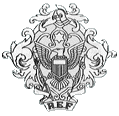
|
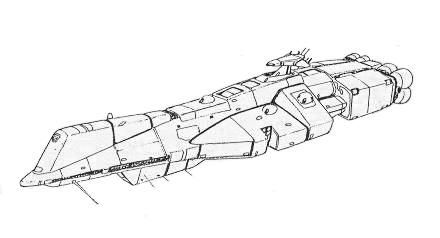
|
 |
 |  |  |  |  |  |
Names and disposition:
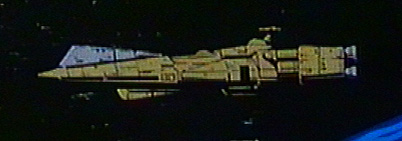
| Hull | Name | Commissioned | Fate |
|---|
| SLS-01 ex SCV-01 | UES Tokugawa | 2014 | In reserve, Tranquillity depot |
| SCV-02 | UES Hannibal | 2014 | Destroyed Second Robotech War, 2030 |
| SLS-03 ex SCV-03 | UES Xerxes | 2015 | In reserve, Tranquillity depot |
| SLS-04 ex SCV-04 | UES Marcus Antonius | 2016 | Destroyed in Invid Invasion, 2031 |
| SLS-05 ex SCV-05 | UES Themistocles | 2016 | In reserve, Tranquillity depot |
| SCV-06 | UES Alexander | 2017 | Destroyed Second Robotech War, 2030 |
The ships were built in the Moon Base Luna shipyards, from 2009-2017.
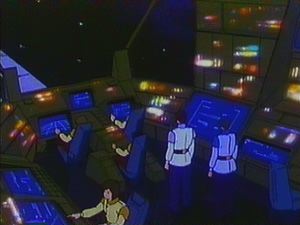
Ship's complement:
Carrier variant:
- Ships' crew (2,600 men),
- Naval Air Group (3,500 men),
- Life support limits far exceeds the numbers for a full combat complement and supernumaries, due to a design requirement for a large evacuation capacity, and the system can handle 150,000 humans comfortably, and more for short periods.
Landing Ship variant:
- Ships' crew (2,045 men),
- Planetary Forces contingent (18,100 men),
- Naval Air Group (1,050 men),
- Life support limits far exceeds the numbers for a full combat complement and supernumaries, due to a design requirement for a large evacuation capacity, and the system can handle 150,000 humans comfortably, and more for short periods.
In both designs the embarking of over 3,000 supernumaries will require hot bunking for some of the crew or the conversion of other spaces for berthing, although as stated the life support system can handle the strain easilly.
Dimensions:
- Length: 1,120 m over all.
- Height: 357 m over all.
- Width : 430 m over all.
- Mass : 10,800,000 metric tons, operational (typical).
- Fuel Mass: 1,280,000 metric tons, maximum (typical).
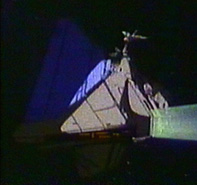
Propulsion systems:
- Main power system: RRG mk 14 protoculture-fueled Reflex furnace. The powerplant of the Tokugawa-class vessel can deliver up to 51.8 Petawatts of power, and can operate for forty-seven minutes at maximum power before overheat initiates autoshutdown.
- Maneuvering thrusters (8): Fusion-plasma reaction thruster clusters mounted on the main hull; top, sides and bottom halfway forward and aft.
- Reaction-mass thrusters (8): Westinghouse HSP-24 Fusion-plasma reaction thrusters with protoculture energizer. These engines are mounted in the port and starboard engine bays, in two quadruple square banks of four engines each.
- Secondary reaction thrusters (4): Rolls-Royce Sparrowhawk fusion-plasma reaction thrusters with protoculture energizer. These engines are mounted as a quadruple bank in the central engine bay, directly behind the main hull.
- Anti-gravity System (1): 23 RRG Cyclops anti-gravity pods.
- Space Fold (1): RRG (Robotech Research Group) Mk3 spacefold. This system generates a spherical fold bubble and can transport 30 to 40 subluminal ships in its fold radius.
- Planetary Capabilities: The Tokugawa-class has atmospheric capabilities through its reaction thrusters and anti-gravity system. The ships' lower body has sufficient strength to let the ship land on it. The ship will float in an ocean.
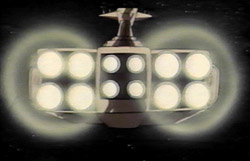
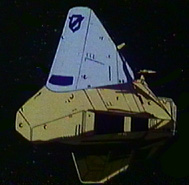
Endurance and mobility limits:
- The dry stores endurance is limited to about 20 years on the Carrier variant and about 10 years on the Landing Ship variant; the on-board recycling installations are very extensive, and only incidental biomass losses need to be replenished. Water stores are recycled almost completely. The hydroponics installations on board will provide the crew with a steady supply of fresh foods, and some can even be 'exported' to smaller ships in the fleet.
- The mecha consumables supplies (mainly missiles) are very extensive, and can sustain continuous combat operations for over twenty-five days for the Carrier variant, and in the Landing Ship variant can support the entire Planetary Forces contingent for twenty days of continuous combat operations.
The ship-launched missile magazines should suffice for one large battle or two or more skirmishes.
- The Reflex furnace can function for about 30 years at normal usage levels before an energizer rebuild is necessary.
- At full power, the main propulsion systems can produce up to 275 Giganewtons of thrust at a minimal reaction mass efficiency profile, or as little as 12.3 Giganewtons of thrust at a maximum efficiency setting. At lower power levels, these thrusts are commensurately smaller.
- At full power, the Tokugawa-class can achieve a maximum delta-v of 194 kps at the cruising acceleration of 0.1 gees, a maximum delta-v of 38.8 kps at the battle acceleration of 1.0 gees, and a delta-v of at most 10.9 kps at the flank acceleration of 2.5 gees. At lower power levels, these ranges are commensurately smaller.
- The fold systems are not navigationally guaranteed for any single jump beyond 10 kiloparsecs. If longer voyages are required, the ships must conduct multiple fold jumps.
- The maximum sustained atmospheric speed is limited to Mach 3. A higher speed can be attained while accelerating to orbit, but this stresses the engines to above their sustainable heat tolerances, and must be limited to orbital ascents. The maximum hover time on the anti-gravity systems is limited only by the protoculture supplies and maintenance requirements.
Weapon systems:
(all)
- Three VLR-5 Skylord rocket vertical launch racks: A set of five rocket silos set into the ship's hull. The rocket fired is the SLBM-sized Skylord, a rocket with a special 3 MT nuclear fusion warhead, an acceleration of 10 g throughout its flight and a delta-v of 10 kps. This missile was also ground-based and could reach a target 175 km high in less than one minute. A conventional warhead was also available. Each installation had five rockets ready for launch, and ten reloads for each rack for a total of 150 rockets on each ship.
- Mk.253 MLS missile systems (6): A vertical launch system with 15 individual launch silos. The silos each contain 6 ready missiles in a rotating mechanism, which can be reloaded while firing. The ready magazines store 310 missiles per launcher. These launchers typically fire Warhawk, and Spacehawk missiles. Typical warheads are anti-mecha cluster munitions, nuclear reaction anti-warship and nuclear reaction re-entry capable weapons. The maximum number of weapons is 2400, of which typically 240 are RMS-3 and Spacehawk-B missiles.
Two launchers are located near the engines, two amidships and two in the bow.
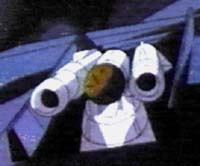
- RRG RG-2 Point defense turret (4): The RG-2 mount is designed to deliver heavy firepower on very close targets. A double barrelled rail gun with a round sensor between the barrels, the RG-2 is stored inside the hull, but elevates upwards from under movable panels into firing position. The RG-2 fires 0.227 kg KPI rounds at 25 kps, giving the rounds a kinetic impact energy of 141 MJ. Maximum effective range for this system is 20 km against mecha sized targets, maximum rate of fire is 120 rounds per minute.
Four of these cannons are mounted in the hull, on the ventral, dorsal, and each flank, abaft the command tower.
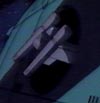
- Oerlikon PD-2 Point Defense turret (8): The PD-2 is a double barrelled laser cannon, with an on-mount multi-spectral sensor. Designed for point defense against mecha, missiles and small vessels, the PD-2 delivers 50 MJ of laser energy four times per second.
Four of these cannons are mounted in the forward hull, the other four are mounted around the engines.
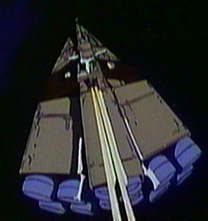
(All, replaced in surviving ships with the RL-39 turret from 2032 onwards)
- RRG PB-90 particle beam system (2): This twin cannon, with an effective range of 300,000 km, is designed to engage other large spacecraft. It can deliver 12000 MJ per salvo, each barrel firing once every five seconds in a medium duration beam mode. It closely resembles an enlarged PB-45
One is mounted on the topside main hull, between the LT-40 and the PB-80, the other is mounted aft of the bridge tower, facing aft-wards.
- RRG PB-80 particle beam system (1): A faster firing, but less powerful weapon than the PB-90, this quad cannon has the same effective range of 300,000 km. Each salvo delivers 7500 MJ, and the mount can recharge every five seconds. It closely resembles an enlarged PB-25.
It is mounted on the topside main hull, just fore of the bridge tower.
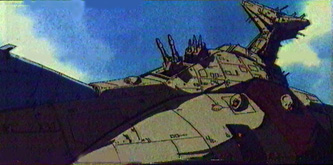
- RRG LT-40 laser turret (12): A fast firing medium caliber laser cannon in a low lying round turret. The cannon can fire 4000 MJ of particle energy as laser pulses with an effective range of 300,000 km, and discharge once every four seconds.
Four turrets are mounted abeam the command tower. One is mounted in front of the forward particle beam battery, one behind the aft particle beam battery. Two are mounted port and starboard on the ventral hull, and the final two are mounted on the ventral centerline.
(SLS-01, -03 and -05, after refit)
- Bofors RL39 Triple Particle Beam Turrets (10). A fully enclosed version of the heavy RL36 turret also mounted on the Garfish class cruisers. These excellent weapons deliver 6000 MJ of particle energy per turret per salvo. The cannons can fire once every three seconds at their maximum discharge rate.
Three turrets are mounted on the upper hull, replacing the double and quadruple barreled turrets, three more are on mounted on the dorsal hull, and the last two are located on each side abreast the command tower.
Air group and mecha complement:
SCV variant:
- Two attack wings with a total of ~1000 veritech fighters, and attack planes.
- Two squadrons with a total of ~20 AEW planes.
- One combined squadron with ~10 EWACS shuttles and Elint planes.
- One combined squadron with ~12 couriers and recovery planes.
- Two combined squadrons with ~14 light and heavy cargo shuttles.
SLS vessels, pre 2032:
(Naval Air Arm, in ready hangars)
- 250 veritech fighters and attack planes.
- Two squadrons with a total of ~20 AEW planes.
- One combined squadron with ~10 EWACS shuttles and Elint planes.
- One combined squadron with ~12 couriers and recovery planes.
- Two combined squadrons with a total of ~28 light and heavy cargo shuttles.
(Planetary Forces mecha, in storage hangars)
- 1750 veritech fighters, bombers, and attack planes.
- approx. 700 Destroids.
SLS-01, -03 and -05, after 2032:
(Naval Air Arm, in ready hangars)
- 200 veritech fighters and attack planes.
- One squadron with ~14 AEW planes.
- One combined squadron with ~8 EWACS shuttles and Elint planes.
- One combined squadron with ~6 couriers and recovery planes.
- Two combined squadrons with a total of ~28 light and heavy cargo shuttles.
Electronics:
- DS-2 Barrier Defense System: An advanced forcefield system which covers the full four pi steradians around the ship with a yellow-greenish forcefield (or if desired, only part of the ship). This field will stop all solids and directed energy weapons (except lasers through a narrow band). However, excess energy which cannot be shunted from the field will be stored in high-capacity capacitators. The storage wattage is not as high as in Reflex-cannon armed vessels, and when the barrier overloads the field will discharge the stored energy particles. This discharge will have the force of a low-yield (less than 1 MT) fusion bomb. However, as the discharged energetic particles' vectors will be away from the field and its generating vessel, it will survive, though it will suffer severe damage to its internal electronics and power systems, and will not be battleworthy until repairs are made.
- DS-1 Pinpoint Barrier Defense System: A smaller system which uses four movable forcefield disks, conformal to the ship's surface, to repel light torpedo attacks, or energy beam fire. It serves as a back up to the DS-2 system.
Design notes:
The Tokugawa-class carriers were among the first vessels, after the ARMD platforms and the Oberth-class Missile Destroyers, to be designed by Earth engineers. The Tokugawa class was designed as the systems of the SDF-1 were still being deciphered, and construction started on the class at the same time as the first metal for the SDF-2 was cut. The carriers were designed to copy the armament philosophy of the ARMD platforms, as well as provide bulk transport for stores and personnel. Consequently, the original design saw the class with six of the large FLBG-1 cannons, as well as a large mecha complement and powerful SLBM rocket battery. As the FLBG-1 weapons proved to be a disappointment on the ARMD class, however, the armament scheme was up for change, and the Orbital Fleet's disastrous engagement with the Zentraedi caused a major redesign. The large cannons were removed, and in their place faster firing though far less powerful weapons were mounted. As this, and the orbital slaughter, proved to be the death knell for the ARMD operational philosophy, the ship was reassigned as a back-up aviation ship, and only the still heavy missile battery saved the ships from cancellation and scrapping. However, the class was no longer intended for the battleline, but as a baseship, transport and orbital fire support base.
The six ships of the class were commissioned between 2014 and 2017, and served until the final REF departure in 2023 partially as baseships for the recon flotillas send out to search for Tirol's coordinates and partially as guard ships in the solar system. Some years after the REF's fold-jump to what turned out not to be Tirol, four of the class (save the Hannibal and Aalexander) were refitted as troop carriers, with much of their hangar space converted into mecha holding bays. The Naval Air Arm complement in the remaining hangars was dramatically reduced and an entire Planetary Forces reinforced corps could be embarked. At this point, the designations of the four vessels were changed from those of carriers (SCV) to those of landing ships (SLS).
The battlecarriers were nearly the size of the SDF-1. However, this class of vessel, in the landing ship configuration, suffered from a lower standard of habitability, since so much internal space was dedicated to mecha storage space and the supplies necessary for prolonged campaigns.
The vessels were built in three main sections. The foremost section contained most of the hangars, and was built in the shape of a blunt wedge, with a large superstructure on top, and a smaller substructure to the rear of the section. Aft of this front section came a central section, capped with the command tower. Behind this was the very massive engine section, with no less than twelve major reaction thrusters.
The landing ship were intended to use their own fighters and armaments, and those of the two unconverted ships, to smash through enemy defenses, and then unload their large Planetary Forces detachment in a few hours on the surface. However, the ships became vulnerable during their re-entry to a planet's surface, when they were unwieldy and incapable of outmaneuvering any attack. Therefore, the REF later switched to troop deployments from the Ikazuchi-class heavy cruisers, with support from the new Horizont landing craft.
The major flaws in this class of vessel were the relatively weak armament and the lack of a one-hit-one-kill heavy gun, despite the fact that the ships were never intended for major naval battles. In addition, the landing ships suffered from the lack of sufficient hangar space for all their enormous mecha complement to be delivered rapidly into battle.
History:
As the SDF-1 was being restored and the Orbital Fleet was under construction, new technological advancements saw the design of the follow-up vessels, the SDF-2 and the Tokugawa class. The SDF-2 was to be a copy of the SDF-1, and the Tokugawa's were to be fold capable follow-ups to the ARMD carriers. After the appearance of the Zentraedi, though, the class was no longer considered fit for frontline service due to proven inadequacies in its basic design. In short, it was proven that the Zentraedi were capable of picking off ships with much the same armament as the Tokugawa's from beyond the range where these could answer the attack effectively. However, production was too far along to change the design, and the need for hulls was urgent, so six ships of the class were built regardless. The first ship of the class, the Tokugawa, was launched in January 2015, with the additional vessels following approximately every eight months after.
At first, the vessels saw service as carriers, carrying a large complement of VF-1 Valkyries and later VF-4 Lightnings and Alphas in space superiority and interceptor roles, and several squadrons of the deadly AF-1 Vulture as their primary attack aircraft. The vessels saw several actions during their early lives, including the Tokugawa's support of the
Lightning squadrons dispatched to disable a small flotilla of Zentraedi ships that had been hiding in the outer system since the destruction of the Zentraedi Homebase. The class was also used as baseships for the flotillas searching beyond the solar system for the coordinates of the capital world of the Tirolian Empire, Tirol.
Some years after the departure of the final ships of the Expeditionary forces, and of the logistical tail, including the Factory Satellite and the Robotech Repair Factory, the decision was made to convert most of the Tokugawa class from less than capable combat vessels to rather more useful troop carriers, the other ships becoming mobile aircraft bases for the ground troops deployed from their half-sisters. Much of the hangar space was converted into mecha storage hangars, and the berthing capacity was greatly expanded to house the large troop contingent. Four of the six vessels were converted.
The UES Hannibal, one of the unconverted hulls, was despatched to Earth upon reception of a distress call. Upon arrival in Earthspace she engaged and was destroyed by the Tirolian fleet, although some of the fighter squadrons and nearly her entire complement (in escape pods) made it safely to Earth.
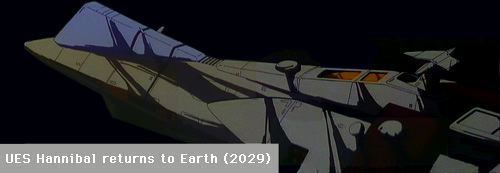
Upon receiving the recall orders from the Earth Robotech Defense Forces, the Expeditionary Force moved to prepare its ships for the foldjump home. Since the Tirolian Fleet would have to be opposed primarily by ship-to-ship combat vessels, only the remaining carrier variant, and one Tokugawa class vessel, the UES Marcus Antonius, were included in the first two waves. Used as a stand-off missile battery and fighter carrier, the Alexander did not survive the battles with the Robotech Masters. The Macrus Antonius unloaded her troops near Monument City in 2030, and was still on the ground during the final, costly battles of that war. The troops she brought home were very active in mopping up the remaining Tirolian forces on the planet. As the war was over, the Expeditionary Force retained the other three Tokugawa class vessels in deep space, while it tried to decide on a course of action for the future, now that the Tirolian fleet had been destroyed over Earth.
This all changed with the disruption of communications between the Expeditionary Forces and Earth. It was immediately suspected, after a malfunction had been ruled out, that an enemy force had invaded the planet and had had at least a partial success. The identity of the attackers was unknown, although the warnings given by Tirolian clone citizens, and transmitted the the Expeditionary force, about the race known as the Invid, were reconsidered and thought possible and in fact likely. Nevertheless, the Expeditionary Force could do nothing but respond with almost its entire operational strength. To this end, the three Tokugawa class vessels and their escorts were loaded with all the ground forcess the Expeditionary Force had available. This fleet, which formed, save for a small guard contingent and the SDF-3 Pioneer, which was in dock for repairs, all the Earth Forces could still field, then folded to Earth in 2031. Upon arrival, the fleet confirmed the Invid presence, and the near annihilation of the Armies of the Southern Cross and the Expeditionary Force vessels that had been send back during the Second Robotech War as reinforcements. The losses in the Invid Invasion included the Tokugawa class, UES Marcus Antonius, which had remained over Earth.
After delivering their troops to the surface, the three landing ships ascended again, and made rendezvous at Moon Base Luna. After it becamse clear that neither the Invid nor the Expeditionary Force was capable of dislodging or destroying the other belligerent, the two powers settled into an uneasy cold war, occasionaly heating up with skirmishes between patrols and suprise raids. The surviving Tokugawa class vessels were assigned to the Home Fleet, of which they formed for many years the capital core task group. This reversal to their designed space control role was only possible because of the practically non existant Invid naval presence. The ships were worked hard, and this was aggravated by the fact that Luna was no longer capable of thorough refits, let alone new construction. When in 2038 the first small Expeditionary Forces attack took place, the Tokugawa's, with the other longer serving ships of the Home Fleet, were once again relegated to second line roles, and in 2042, after the disastrous 1st Mars Division attack and upon the arrival of more and more modern ships in the system, the class was reduced to reserve in order to free their crews to help man the new vessels. The class remained in reserve throughout the rest of the war, and are still listed in reserve, although, realistically, they would need an extensive and long overdue refit before entering service again. However, the class is now totally obsolete, and is likely to be stricken and scrapped soon.
See additional design notes.
Return to REF Naval index.
Go to Robotech Reference Guide Home Page.
Robotech (R) is the property of Harmony Gold. This document is in no
way intended to infringe upon their rights.
Content by Pieter Thomassen and Peter Walker, with Rob Morgenstern
HTML by Robert Morgenstern (rmorgens@ieee.org)
Copyright © 2004, 2003, 2001, 1999, 1998, 1997 Robert Morgenstern, Pieter Thomassen, Peter Walker













